2004 Honda Rune
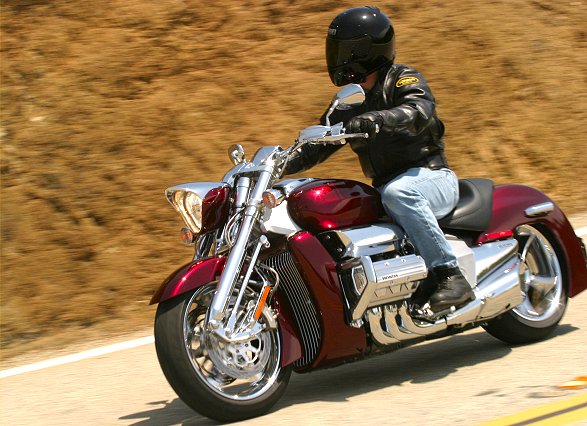
This is difficult to write. I feel that I am not only commenting on the Honda Rune, but on a sea change at one of the world's largest corporations.
Honda doesn't build $27,000 "custom" motorcycles. Honda doesn't create a design study, stay strictly loyal to that design, and work "backwards" towards a production machine. Of course, all of this was true before the Rune. Now, it's not necessarily true. The Rune proves Honda can work this way.
Manufacturing motorcycles (or cars — another thing Honda does) isn't entirely about making money on products that sell in large numbers (although, Honda is pretty good at that part, too). Part of it is about building a brand image. This is why Honda (and several other companies) are involved in motorsports — to the tune of tens of millions of dollars per year. Honda is involved in F1 automobile racing, grand prix motorcycle racing, and off-road racing, for instance. Those activities are intended to strengthen the Honda brand, but standing alone, they lose money.
The most effective way to draw attention to a brand, however, is to build an exciting product. A product that is different . . . even a bit outrageous. A product that says "watch us, we can build anything and we will surprise you." The Rune does this for Honda.
The Rune makes you think differently about Honda, as well. When you used to see a wild concept motorcycle from Honda that inspired you, you would think: "That's a really cool design, but, if it ever goes into production, I'm sure it will get watered down." Now, you have to think Honda might build it just the way it looks.
It might be easy to conclude that the Rune is nothing more than an image builder for Honda . . . purely a "loss leader", like a racing program. It would be easy, that is, if the Rune didn't function as well as it does, because the Rune is a marvelous motorcycle from a functional perspective, not just from a style perspective.
In our article introducing the Rune, we told you about the unique way Honda approached the development of this remarkable motorcycle. If we left you with the impression that the Rune is "all show and no go", it was the wrong one. As we found out on our first ride of the Rune (covering more than 100 miles, with plenty of freeway, twisty roads, and everything in between) the Rune backs up its hot rod looks with surprising performance.
There are four elements of the bike that should be highlighted when discussing this first ride. The engine, the aluminum chassis, the massive brakes, and the unique suspension system.
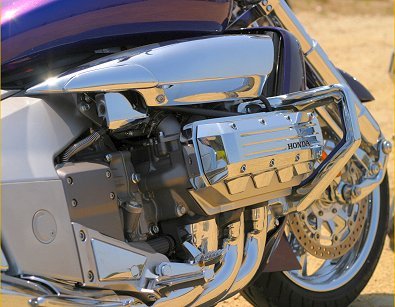
The Rune's 1832cc six-cylinder engine (derived from the Gold Wing, but modified for even higher performance) is the heart and soul of this bike. Honda claims this massive power plant puts out more torque than any other production motorcycle engine, and we believe it. With six, separate 32mm throttle bodies, and a huge, 6.9 liter airbox feeding this angry beast of an engine, it also breathes more freely through a higher-flowing (and superb sounding) exhaust system.
The version of this engine developed for the 30-pound-heavier Gold Wing has just two throttle bodies and a bit more choked-up intake and exhaust system. Despite that, the Gold Wing moves out smartly, and has the torque to shrug off the weight of a passenger and luggage (and even a trailer). The Rune is just something else, however.
With all that torque and horsepower (Honda isn't quoting power or torque figures), the Rune has that special, omnipotent feeling . . . sort of like a big-block v-8 American engine in a lightweight car. Just a whiff of throttle sends the Rune surging forward, while a full handful of throttle makes it leap towards the next corner.
The solidly mounted engine sends some pleasant vibes to the rider (no, it's not a v-twin, but the vibes are pleasant. nonetheless) without ever getting close to an annoying level of vibration. Indeed, the six-cylinder is remarkably smooth and composed, and features a powerband a mile wide.
Once above 30 mph, you could literally leave the Rune in fifth gear and still have healthy acceleration on demand. If you get a chance to ride a Rune, use all five gears, however, just so you can hear the engine scream a little (it really does sound good — again, sort of like an American v-8 with an aftermarket muffler).
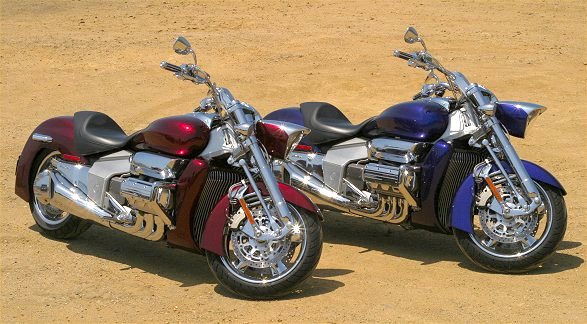
The Rune chassis is a pleasant surprise, as well. A very stiff aluminum diamond-shaped frame helps stretch the wheelbase to 68.9 inches, the longest in Honda's line up. It also remains remarkably composed when the Rune is pushed hard by that brutish engine. Indeed, the Rune has one of the stiffest chassis available from a cruiser (Yamaha's Road Star Warrior is the only other aluminum-framed cruiser I can think of).
Those brakes I mentioned are the largest ever put on a production motorcycle by Honda, in terms of total brake rotor diameter. Dual 330mm discs up front, and a single 336mm disc out back. Three-piston calipers in front work through Honda's linked braking system with a two-piston caliper in the rear.
We mentioned the unique suspension of the Rune in our introduction. It includes a trailing bottom-link front fork that transfers axle loads through pushrods and linkage to two upper shocks, one housing the main spring and one a sub-spring and damping system. 3.9 inches of front travel are available on the Rune.
In back, a version of Honda's Unit Pro-Link rear suspension is used less than two years after it made its debut on Honda's MotoGP racer, the RC211V. The Unit Pro-Link lacks the traditional top frame mount for the shock, and, according to Honda, thereby eliminates negative suspension energy from being transmitted into the frame.
We'll save the detail specs for our full ride review in a few months (Honda said we can have a Rune for a more extensive test when more become available — there are only two available in the United States for members of the press to ride, at this time). Let's talk more about our first ride.
The Rune is a massive bike. When you first sit on it, the headlight seems to stretch to the horizon in front of you. The bike has a heavy, solid feel as you lift it off the side stand, but once you are moving it feels well balanced and, like most other Hondas, easy to ride.
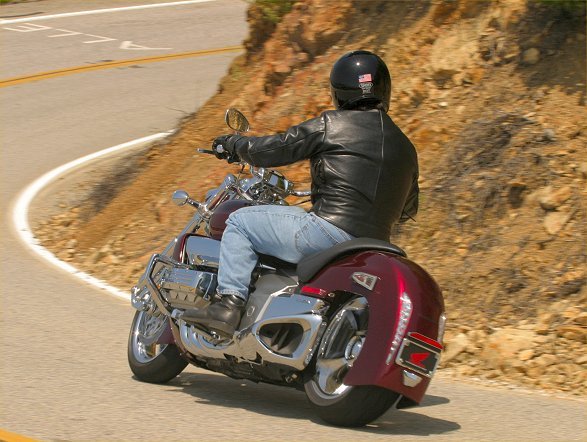
Indeed, every functional aspect of the Rune seems well thought out and well developed. The fact that this bike was engineered in reverse order (designed purely for aesthetic purposes, and engineered to work in that configuration) doesn't really seem to affect performance, whatsoever.
As you might expect, the engine is very well sorted out. The refinements added to the Gold Wing power plant leave everything working smoothly and predictably — there is just more power, more torque, and more noise. The transmission shifted well enough that I successfully experimented with clutchless upshifts (try that on a big v-twin). Yes, this is a Gold Wing motor . . . with attitude!
Some motorcycle engines make you feel all powerful, like King Kong. That's what this motor makes you feel like, within a block or two (or, at least, the first chance you get to twist the throttle hard). With a motor like this, you need plenty of brakes.
The linked-braking system that works so well on the Gold Wing (it really is transparent now on the new Hondas — they have really refined their linked braking system) is an asset on a 769 pound machine, believe me. I still don't care for linked brakes on sport bikes (or even lightweight sport tourers), but I loved it on the Gold Wing, and I love the brake set-up on the Rune. Braking power comes on very progressively, but you feel like you can haul the Rune down as quickly as its tires will permit, in almost any circumstance.
The unique suspension works well, also. Although the Rune felt a bit floaty on California's freeway whoops (certain California freeways have equally-spaced mounds that can wreak havoc on a vehicle's suspension composure), the bike felt very composed just about everywhere else.
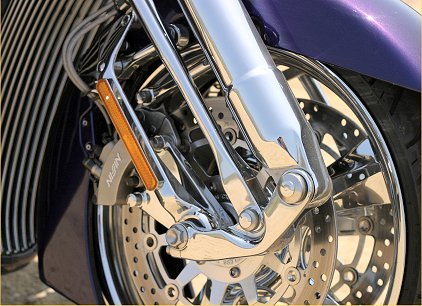
The fork looks cool, and different, but it feels totally conventional when you are riding the Rune. The fork absorbs bumps like a conventional system (no better and no worse) and reacts to steering inputs conventionally.
Like most cruisers I ride (and weighing close to 200 pounds), I did bottom the rear shock a few times. The Rune offers 3.9 inches of travel back there (not too bad for this class) and, I have to admit, reaches a pretty good compromise between comfort and bottoming resistance, on the whole.
The two test bikes we had available featured the two, optional handlebars, one more rear-set than the other. The rear-set bar felt better cruising in a straight line, but the forward-set bar provided more confidence while cornering.
The seat was comfortable, and, as I stated earlier, the rider is not subject to any annoying vibration through either the bars or the pegs.
I did have some crowding of my size 11 boot on my left foot, as the cylinder head seemed to compete for space above the shift lever. Indeed, the flat six-cylinder motor prevents Honda from putting the pegs in the far-forward position found on many cruiser machines, but the ergonomic triangle (bar/seat/footpeg relationship) was comfortable overall, and lent the rider a good sense of confidence controlling the machine. The digital instrument gauge is easy to read on the Rune for two reasons. First of all it is very bright, and second, it is shaded by a deep hood, that prevents glare from interfering with legibility.
While cruising on the freeway at up to 80 mph, the Rune provided remarkable wind protection to the rider. I say remarkable, because the Rune comes without a fairing, and most cruisers send enough wind blast to your chest on the freeway that you are holding on for dear life. Something about the front end of the naked Rune minimizes the air pressure against your chest at higher speeds. It made travelling on the freeway much more comfortable than I expected.
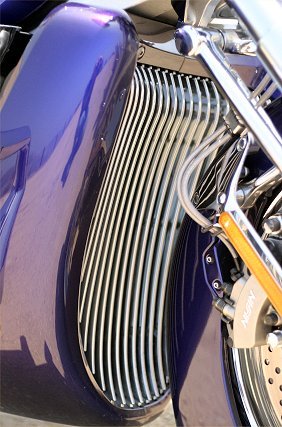
I'll end this discussion of the Rune's performance on our first ride with a little anecdote. I was riding with one other journalist (there are only two Runes, remember?) and a Honda press representative, who was aboard an ST1300. We spent part of our time on some twisty roads in the Malibu area. Before lunch, I trailed the group (led by the Honda rep), and the journalist in front of me wasn't pushing hard (the guy on the ST1300 pulled away — undoubtedly, wanting to make sure that we had room to push the bikes as hard as we wanted). After lunch, I decided to slot myself in front of the other journalist, and see if I could push the ST1300 rider through the twisties. As we left the other journalist quite a ways back, I pushed the ST rider as hard as I could. For the most part, I stayed a safe distance behind him, without losing ground. I did drag the Rune's footpegs through several corners, but the 15 minute romp through the tightest twisties of the day was an absolute blast, and it was here that the Rune drove home its chassis rigidity, suspension composure and braking prowess. It was also here that the engine's ability to squirt the massive bike from corner to corner was most noticeable.
In the end, the Rune was a lot of fun to ride. It almost goes without saying that it also attracted a great deal of attention from fellow motorists and pedestrians. Although the styling borders on outrageous, it is clearly attractive to a good number of enthusiasts (not only based on comments we received during the ride intro, but the favorable email received by MD following the publication of our preview article). Honda was correct that the Rune pushes a lot of the right buttons from a styling perspective. We found out it also pushes the right buttons from an enthusiast's performance perspective, as well.

Stay tuned for a more thorough ride review a bit later. In the meantime, you may see a Rune on the floor at your local Honda dealer within the next month.
You can follow any responses to this entry through the RSS 2.0 feed. Both comments and pings are currently closed.
Source: https://www.motorcycledaily.com/2003/06/19june03hondarune1stride/

0 Komentar